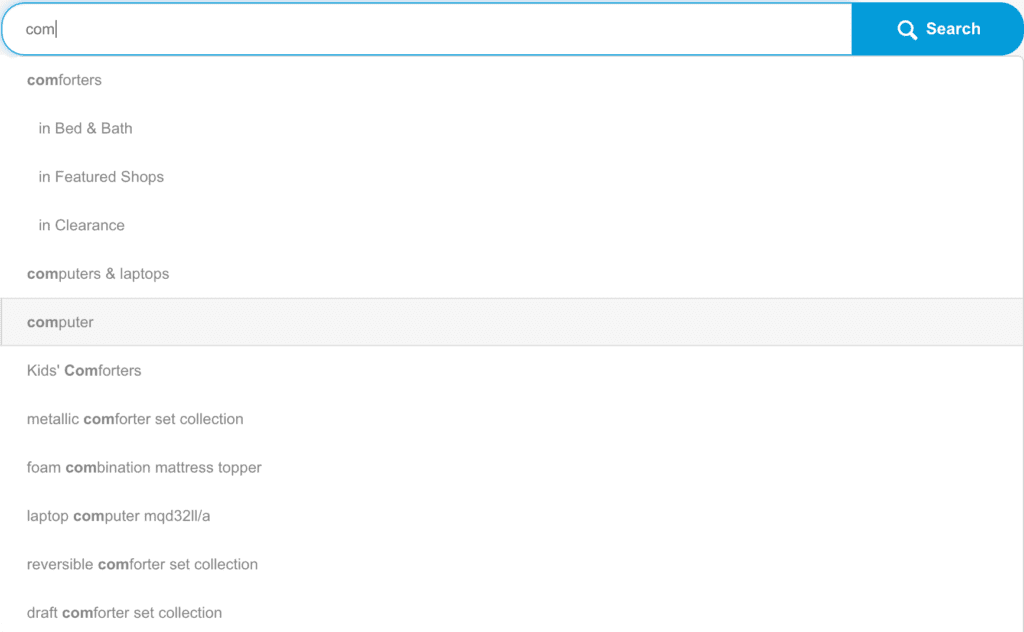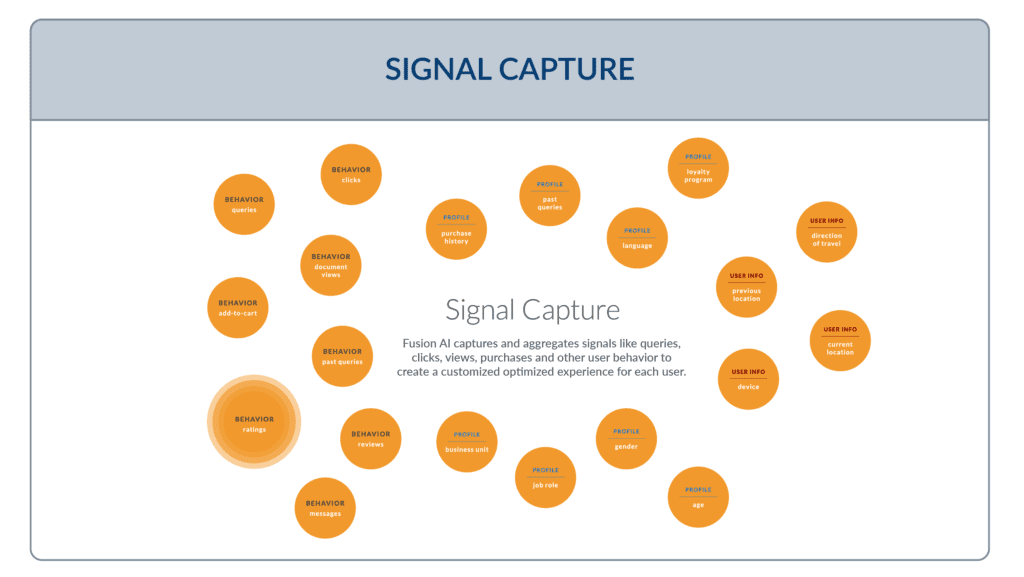How Machine Learning and Autocomplete Guide Users to More Conversions

Autocomplete, that feature that predicts what you are trying to type after only has few keystrokes, has been a standard Google feature since 2008. And like most Google’s trends, it has now become a de facto standard for ecommerce websites. Also called auto-suggest and type-ahead, the feature can be powered by metadata and/or by machine learning. Not surprisingly, machine learning provides far greater accuracy — while metadata management become a virtual arms race to keep up.

The most common ways companies create metadata is by looking at the logfiles — and identifying all the misspellings and synonyms. And while this is a great first step, the English language is complicated. Many things can go awry, from misinterpretation of the word the user is starting to spell, leading to irrelevant or null results, to suggestions that are so far off base that they are almost laughable.
Further maintaining a metadata-based dictionary/thesaurus is hard as it requires either a ton of manual work or expensive text analytic tools to create the metadata. And if a new typo or a new term is used that wasn’t in the dictionary — well they won’t be found until after the would-be customer is long gone.
According to a survey by the Nielsen Norman Group (NNG), only 23 percent of consumers who use autocomplete actually click on a result, strongly indicating the suggestions weren’t helpful.
Is it because the words in the drop-down are not the right ones? Are there too many? Too few? Too poorly designed to decipher?
When you consider that 30 percent of your visitors first engage through search — and 80 percent of those people leave without clicking on anything — perfecting type-ahead makes good business sense.
How Autocomplete Drives Conversions

As an example, a leading mass specialty retailer with more than $100 billion in sales and global scope finds auto-suggest is essential to user experience and conversion to revenue. I spoke with the firm’s IT architect and engineering manager, who needed to remain anonymous. He told me that continually improving autocomplete is a priority because its impact is so great.
And the retailer’s efforts to proactively improve autocomplete are paying off.
As noted, while NNG saw only 23 percent clickthrough on type-ahead, this firm reports that roughly 50 percent of its visitors click on one of the suggestions that appear after only a few characters are typed. But the IT manager points out that those figures do not take into account the full impact of auto-suggest.
We can only measure the number of people who actually clicked on a suggestion,” he says. “I argue that there are two components. One is explicit engagement, in which the user actively selects a suggested query. The other is implicit, in which the user is influenced by the suggestions in the drop-down.”
In the latter case, users type out words from a suggestion directly into the search box rather than moving the cursor to pick the suggestion.
How Machine Learning Impacts Type-ahead
Expanding the system and adding new features is always secondary to making sure the search engine performs its basic function very well. Like a house with a problem at its foundation, no amount of window dressing — that is, no other function or feature — will make any difference if consumers cannot find the products they want.
“You’re going to get your revenue by having a firm foundation,” my source tells me. “What’s important is not fancy features; rather, it is making sure that your system is solid. When anything goes wrong with the basics, it will chase away people, and they’re not going to trust your system.”
Type-ahead requires an understanding of user intent. One of the means of determining this is to analyze user queries: What words did they use to search (and how did they mis/spell those terms)? Which ones yielded a clickthrough? Which ones didn’t?
You can do that by hand, but it takes lots of hands. Or you can use AI/machine learning.
Machine learning applies mathematical algorithms to log files and user behavioral signals to generate and rank the most relevant type-ahead autocomplete suggestions. But that’s only half the equation. The other half is testing and tweaking the algorithms to get the results you want. Unfortunately, not all machine learning vendors allow that.

Explainable AI Allows Greater Control
The firm had previously used a search vendor that took a black-box approach to AI, meaning that developers could not access the underlying AI logic or make changes to the code.

“We didn’t have much opportunity to make revisions to tailor the engine to our specific business needs,” my source explains. Because they wanted an open platform with explainable AI, the firm switched to Lucidworks Fusion four years ago.
Fusion learns from the millions of searches on retail chain’s site, which refines the type-ahead suggestions. But it has taken a partnership between Fusion and the retailer’s developers and data scientists to cultivate a type-ahead implementation that yields more than double the interaction other commerce sites are seeing.
“We have the resources to do active development, so our programmers can now modify the code and add additional features as needed,” the IT manager tells me. “So, we are continuously expanding the system and integrating new logic and modules into it.”
One common business use for explainable AI is to integrate the merchant’s perspective into autocomplete and search results. Auto-suggestions are rendered automatically by the Fusion AI algorithm, which produces the queries most likely to capture the searcher’s intent based on the user’s behavior and patterns of similar searches.
However, it is possible for the retailer’s engineers to modify the code so that some suggestions will have a more commercial slant. The firm’s autocomplete default is to provide the NNG-recommended 10 suggestions in the drop-down menu, which offers an opportunity to use some of them to name a preferred vendor, a product that buyers would like to promote or a high-end item within the category. None of these merchant-guided suggestions would show up without a boost from programmers.
The manager says using autocomplete to predict user intent and drive revenue is a balancing act. “We are constantly getting requests from product managers because they care which product gets sold,” he says. “But we care more about how we render the best user experience so that people can find what they are looking for.”
The question is, will users be bothered by suggestions that seem to be driven by revenue considerations or will this firm and others like it be leaving money on the table by not incorporating some commercially-driven options?
Best Kind of Site Guided-Navigation
Baymard Institute, an independent web usability research firm, has studied what consumers actually do on ecommerce sites and what they think about the experience for tens of thousands of hours over the past decade.
In an article on autocomplete, Baymard writes, “When autocomplete suggestions work well, they help the user articulate better search queries. It’s not about speeding up the search process, but rather about guiding the user and lending them a helping hand in constructing their search query.
“During testing, autocomplete suggestions were found to directly alter how and what the test subjects searched for,” the article continues. “Autocomplete suggestions furthermore act as reassurance as the user types and sees matches related to their query, often prompting them to add further details to the query as long as relevant autocomplete suggestions keep appearing.”
My home improvement source told me that the strategy of showing a wide breadth of autocomplete suggestions is correlated with a better conversion rate.
“Type-ahead is at the top of the search funnel, and we want to make our funnel as big as possible,” he says. “It’s not a good user experience if you have typed several characters and there’s no suggestion. The ideal situation is that as you keep typing, there will always be a suggestion for you, and it will lead to a good search result.”
LEARN MORE
Contact us today to learn how Lucidworks can help your team create powerful search and discovery applications for your customers and employees.